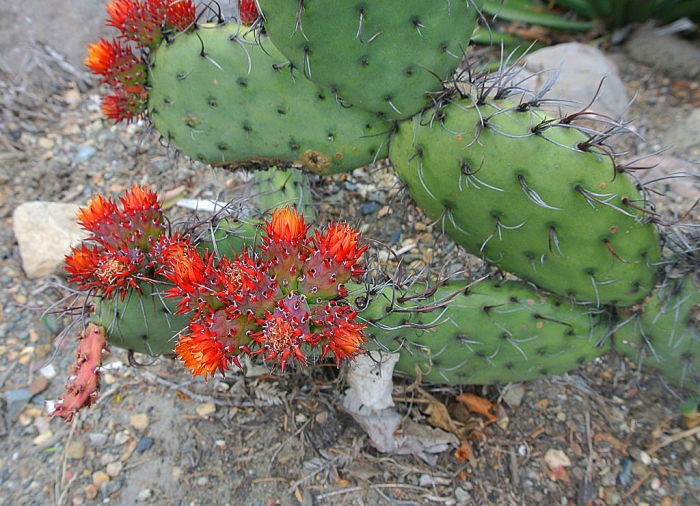Nopal Serrano
(Opuntia stenopetala)
Nopal Serrano (Opuntia stenopetala)
/
/

Dick Culbert
CC BY 2.0
Image By:
Dick Culbert
Recorded By:
Copyright:
CC BY 2.0
Copyright Notice:
Photo by: Dick Culbert | License Type: CC BY 2.0 | License URL: https://creativecommons.org/licenses/by/2.0/ | Uploader: Dick Culbert | Publisher: Flickr |
















Estimated Native Range
Summary
Opuntia stenopetala, commonly known as Nopal Serrano, is an evergreen succulent plant native to arid and semi-arid regions, specifically the Chihuahuan Desert and scrublands in Northeast Mexico and areas adjacent to the Gulf of Mexico. It typically grows to a height of 1-2 feet (0.3-0.6 meters) and a width of 2-3 feet (0.6-0.9 meters). This cactus has a distinctive appearance with its flattened, paddle-shaped stem segments called cladodes, which are covered with small spines. The flowers, which appear in the spring and summer, are red and brown, and they are quite showy, attracting pollinators such as bees and hummingbirds. As a dioecious species, it has male and female flowers on separate plants, requiring cross-pollination for fruit production.
Nopal Serrano is valued for its drought tolerance and unique aesthetic, making it a suitable choice for xeriscaping, rock gardens, and as a specimen plant in areas with a desert-like theme. It is also cultivated for its edible pads and fruits, which are used in traditional Mexican cuisine. In terms of care, it thrives in full sun and requires minimal water once established, making it a low-maintenance option for gardeners. It prefers well-draining soils and is tolerant of poor soil conditions. While generally pest-resistant, it can be susceptible to cochineal scale insects. Gardeners should handle this plant with care due to its spines, and it is advisable to plant it away from high-traffic areas to prevent injury.CC BY-SA 4.0
Nopal Serrano is valued for its drought tolerance and unique aesthetic, making it a suitable choice for xeriscaping, rock gardens, and as a specimen plant in areas with a desert-like theme. It is also cultivated for its edible pads and fruits, which are used in traditional Mexican cuisine. In terms of care, it thrives in full sun and requires minimal water once established, making it a low-maintenance option for gardeners. It prefers well-draining soils and is tolerant of poor soil conditions. While generally pest-resistant, it can be susceptible to cochineal scale insects. Gardeners should handle this plant with care due to its spines, and it is advisable to plant it away from high-traffic areas to prevent injury.CC BY-SA 4.0
Plant Description
- Plant Type: Succulent
- Height: 1-2 feet
- Width: 2-3 feet
- Growth Rate: Moderate
- Flower Color: Red, Brown
- Flowering Season: Spring, Summer
- Leaf Retention: Evergreen
Growth Requirements
- Sun: Full Sun
- Water: Low, Medium
- Drainage: Medium
Common Uses
Bee Garden, Bird Garden, Butterfly Garden, Deer Resistant, Drought Tolerant, Fire Resistant, Hummingbird Garden, Low Maintenance
Natural Habitat
Native to arid and semi-arid regions, specifically the Chihuahuan Desert and scrublands in Northeast Mexico and areas adjacent to the Gulf of Mexico
Other Names
Common Names: Arrastradillo
Scientific Names: , Opuntia stenopetala, Opuntia grandis, Opuntia glaucescens, Opuntia stenopetala var. inerme, Opuntia arrastradillo, Opuntia riviereana, Opuntia marnierana, Opuntia marnieriana,
GBIF Accepted Name: Opuntia stenopetala Engelm.